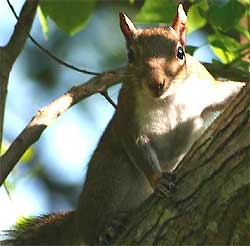
Squirrels, such as the Eastern Gray Squirrel, Sciurus carolinensis, at the right, as well as chipmunks, mice and rats, all belong to the order Rodentia. Thus squirrels are rodents.
A feature uniting squirrels and chipmunks with rats and mice is their teeth. In the front of all rodent mouths, including those of squirrels and chipmunks, there are four chisel-like gnawing-teeth called incisors, two above and two below. This can be seen in the picture below of the lower jawbone of a chipmunk. 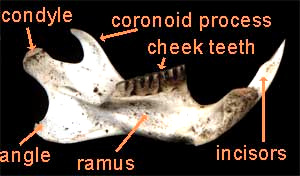 Immediately behind all rodent incisors there's an empty space, and then come flattish back teeth. These back teeth, or "cheek" teeth, are adapted for grinding. The vast majority of rodents also have four toes on each front foot, and five on each hind foot.
Immediately behind all rodent incisors there's an empty space, and then come flattish back teeth. These back teeth, or "cheek" teeth, are adapted for grinding. The vast majority of rodents also have four toes on each front foot, and five on each hind foot.
"TREE SQUIRRELS"
Inside the rodent order, the Squirrel Family, the Sciuridae, is a big family holding not only squirrels and chipmunks but also ground squirrels, prairie dogs, woodchucks, and marmots. Often the squirrels inhabiting our backyard trees are called "tree squirrels," in order to not confuse them with other squirrel types. Burt & Grossenheider's A Field Guide to the Mammals recognizes the following North American tree-squirrel species:
Western Gray...Sciurus griseus
Tassel-eared...Sciurus aberti
Eastern Gray...Sciurus carolinensis
Arizona Gray...Sciurus arizonensis
Eastern Fox....Sciurus niger
Apache Fox.....Sciurus apache
Red............Tamiasciurus hudsonicus
Chickaree......Tamiasciurus douglasi
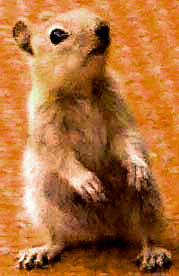
In the eastern U.S. and adjacent Canada the common "park squirrel" is the Eastern Gray Squirrel. In California, western Oregon, and west-central Washington, it's the Western Gray. Other tree squirrel species are more restricted to wild areas, though some have learned to beg from campers and picnickers in parks.
Just because a mammal is called a squirrel doesn't mean that it's a tree squirrel. The Golden-mantled Squirrel at the right, Callospermophilus lateralis, is a member of the Squirrel Family, but the Ground Squirrel Subfamily, the Xerinae, along with groundhogs, marmots and prairie dogs. This golden-mantled Squirrel was photographed by Diana Adams inside a large tent full of humans attending a camp meeting in California's Sierra Nevada Mountains.
CHIIPMUNKS
Even more species of chipmunks exist than squirrels, and once again most species occur in the western states and provinces, and most are found in the mountains.
A Field Guide to the Mammals recognizes the following North American chipmunk species:
Eastern.........Tamias striatus
Alpine..........Eutamias alpinus
Least...........Eutamias minimus
Townsend........Eutamias townsendi
Cliff...........Eutamias dorsalis
Sonoma..........Eutamias sonomae
Yellow Pine.....Eutamias amoenus
Merriam.........Eutamias merriami
Grayneck........Eutamias cinereicollis
Long-Eared......Eutamias quadrimaculatus
Redtail.........Eutamias ruficaudus
Colorado........Eutamias quadrivittatus
Uinta...........Eutamias umbrinus
Panamint........Eutamias panamintinus
Lodgepole.......Eutamias speciosus
Charleston Mtn..Eutamias palmeri
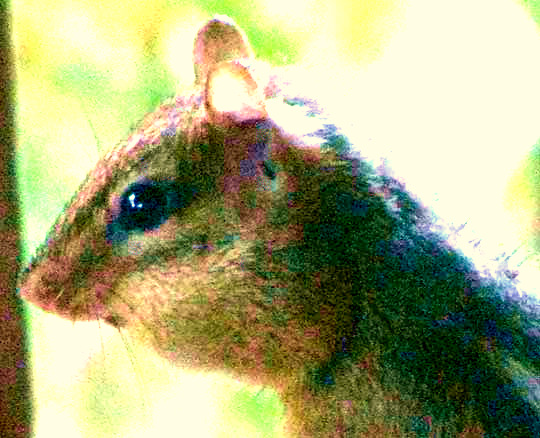
In most of Eastern North America the only chipmunk species seen is the Eastern. One difference between tree squirrels and chipmunks is that chipmunks have internal cheek pouches in which they temporarily store food as they forage on the ground -- using them like pockets. The chipmunk at the right has his pouches full of something, making him look like he has the mumps. Tree squirrels don't have such pouches, though ground squirrels do. Though chipmunks can climb trees, they're more ground-oriented than tree squirrels. Typically they live in burrows in the ground, especially in rocky areas and among tree roots.
SQUIRRELS ARE DIURNAL
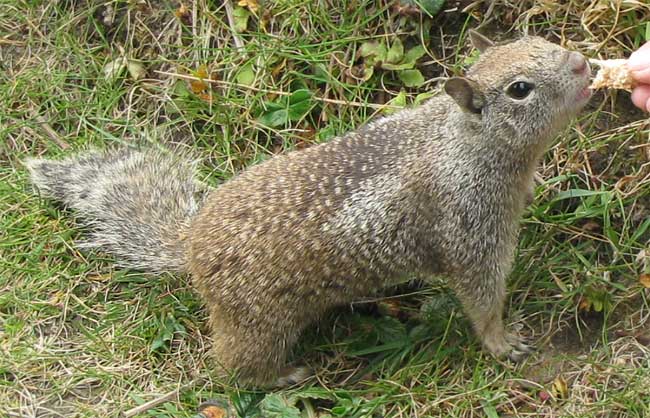
All members of the Squirrel Family, such as the California Ground Squirrel, Spermophilus beecheyi, at the left, but NOT the flying squirrels, are diurnal; they're active during the day. This is rare among wild mammals! And it's fortunate for us backyard naturalists, for it makes squirrels relatively easy to watch.
Why are squirrels diurnal while most other mammals are strictly nocturnal -- active during the night? A good guess is that members of this family are so good at escaping predator attacks that they just don't have to slink around in the night. Chipmunks, ground squirrels, prairie dogs, woodchucks, and marmots are seldom seen far from their burrows. And tree squirrels... well, just watch what they do when the neighbor's dog sees one on the ground! In a flash the squirrel will be up a tree!
After a rain, in muddy places, you might look for footprints of squirrels and chipmunks, as sketched below:
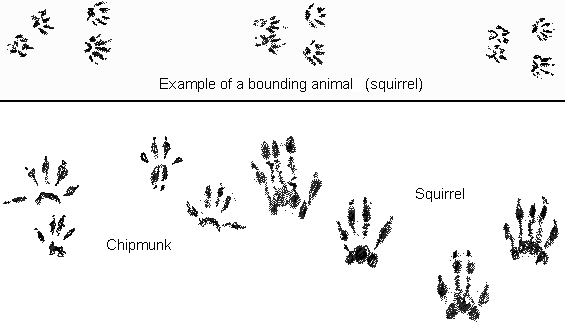
SQUIRREL BEHAVIOR
Despite their ability to escape, hawks attack them, snakes enter their nests and, in towns, domestic house cats catch enormous numbers of squirrels by waiting, waiting, waiting until a squirrel wanders along...
One reason squirrels come to the ground is to bury and retrieve food. In the fall often you see them digging small holes in the ground into which they deposit food, especially nuts and acorns. These holes are called caches (pronounces CASH-ez). Squirrels may cache thousands of nuts and acorns during a season. On warm days throughout the winter when food is scarce the squirrel descends to the ground and digs up its treasures. Many nuts and acorns are never retrieved, so they sprout in the spring, and develop into trees. Thus one important job the squirrel does in the ecosystem is to plant trees.
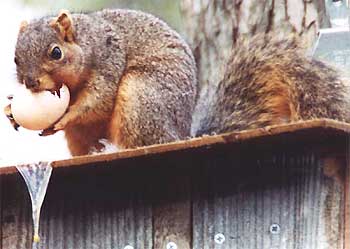 Eastern Fox Squirrel, Sciurus niger, eating Wood-duck egg. Photo courtesy of Ken Bonnell in Mississippi
Eastern Fox Squirrel, Sciurus niger, eating Wood-duck egg. Photo courtesy of Ken Bonnell in MississippiEspecially with a pair of binoculars you can see plenty of tree-squirrel behavior -- such as shown at the right. You might also see squirrels building two kinds of tree-nests. Courtship between males and females is very complex and dramatic, and so is the conflict among males to establish who's top squirrel in the neighborhood. When young emerge, you can watch them foraging with their mother, learning how to eat various foods, and getting into all kinds of mischief. Once you gain a little practice watching them, following them, figuring out what they're doing, and making good notes, you'll be surprised how much of this wild animal's life cycle you can chronicle!
ONLINE BOOK ABOUT A SQUIRREL

Jim Conrad has written and illustrated a story about a tree squirrel called Mistletoe. The story follows Mistletoe throughout an entire year and offers a kind of "insider's view" to what it's like being a squirrel. Though Mistletoe has a number of wild adventures, all of her behavior is what would be expected of a real-life squirrel in similar situations. The book is freely available online.
